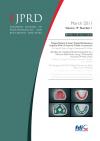European Journal of Prosthodontics and Restorative Dentistry

- Cover Date:
- March 2011
- Print ISSN:
- 0965-7452
- Vol:
- 19
- Issue:
- 1
EJPRD Mar11 911-Radford pp11-14.pdf
Eur. J. Prosthodont. Rest. Dent., Vol.19, No. 1, pp 11-14 Printed in Great Britain
© 2011 FDI World Dental Federation doi:10.1922/EJPRD_911Radford04
The Fatigue Life Of A Cobalt-Chromium Alloy After Laser Welding
Nabil Jalal Ahmad Al-Bayaa*, Robert K.F. Clark†, Andrzej S. Juszczyk‡ and David R. Radford§
Abstract - The aim of this study was to investigate the fatigue life of laser welded joints in a commercially available cast cobalt-chromium alloy. Twenty rod shaped specimens (40 mm x 1.5 mm) were cast and sand blasted. Ten specimens were used as controls and the remaining ten were sectioned and repaired using a pulsed Nd:YAG laser welder. All specimens were subjected to fatigue testing (30N ~ 2Hz) in a controlled environment. A statistically significant difference in median fatigue life was found between as-cast and laser welded specimens (p<0.001). Consequently, the technique may not be appropriate for repairing cobalt chromium clasps on removable partial dentures. Scanning electron microscopy indicated the presence of cracks, pores and constriction of the outer surface in the welded specimens despite 70% penetration of the weld. KEY WORDS: Laser welding, Cobalt chromium alloy, Fatigue strength
INTRODUCTION
Cobalt-chromium (Co-Cr) alloy is the material of choice for the metal framework of removable partial dentures (RPD). Soldering and brazing are conventional methods used for joining Co-Cr alloy components1, however, it is difficult to use these methods to repair the fractured parts of an existing prosthesis due to the need to heat a large area, which may lead to the acrylic resin components being affected2,3. Laser welding can be used to join parent metals using only localized heat. The tensile strength of welded joints in cast Co-Cr wires has been found to be considerably less than the tensile strength of unwelded wire4. However, tensile failure of a Co-Cr component in service is unlikely as fatigue fracture would be a more likely cause of failure. The clinical experience of loss of retention of an RPD after a period of service, suggests that repeated deflection of the clasps retaining the denture in function and during insertion and removal of the denture may cause metal fatigue in a clasp5. Laser welding offers a convenient method for joining cobalt-chromium components during construction and repair of RPDs6. However, little appears to have been reported in the literature of the fatigue life of Co-Cr alloys or the effect of laser welding on fatigue life. Thus, the aim of this study was to compare the fatigue life of Co-Cr alloy after laser welding with the fatigue strength of “as cast" specimens. The null hypothesis was that there was no difference in the fatigue life between the laser welded Co-Cr alloy and the “as cast†alloy.
MATERIALS AND METHODS
20 specimens (40mm +/-0.1mm x 1.5 mm +/-0.1mm diameter) were cast using round profile wax as a pattern. After casting the specimens were finished by sand blasting using extra course silica free blast grit (particle size, course; grade 60/80). Ten specimens formed a control group. Ten specimens were sectioned centrally and then rejoined by laser welding. A repositioning jig was used to locate the two ends to be welded using a pulsed Nd: YAG laser. The parameters for welding were frequency at 1 Hz, pulse duration at 10 ms, voltage 200A and spot diameter 0.5 mm1. Specimens were inserted into the welding machine on the repositioning jig. The first weld spots were undertaken opposite to each other so as to maintain the correct alignment. A double welding technique was used so as to increase the joint strength of the weld7,8. A previously advocated overlapping technique of 70% was used 9,10,11 to avoid distortion. Specimens were subjected to fatigue testing using a universal SMAC machine (Fig 1). A computer controlled linear actuator with a stroke length of 15 mm was set to deliver a force of 30N at a speed of 2Hz. Each specimen was fixed between the 2 grips of the machine, and the fatigue test was undertaken, the software was programmed to stop at the time when the specimen fractured. The number of cycles was calculated and the fractured specimen was stored dry. The microstructure of the fracture ends of the welded and the “as cast†specimens was investigated using SEM. Specimens were selected randomly, three per group, mounted on an aluminium stub using carbon cement. Specimens were sputter coated with gold to ensure optimal conductivity. Each specimen was viewed in a Hitachi S 3500N scanning electron microscope using an accelerating voltage of 12KV at magnifications of x45, x150 and x1000.
* BDS MSc †BDS PhD FDS ‡ LCGI, PhD § BDS PhD FDS MRD
- Article Price
- £15.00
- Institution Article Price
- £
- Page Start
- 0
- Page End
- 0
- Authors
Articles from this issue
- Title
- Pg. Start
- Pg. End
- Bonding of a Gingival Shade Composite to a Denture Base Resin using a Chemically Activated 4-Meta Resin
- 7
- 10
- Comparison of Linear Dimensional Change, Surface Hardness and Surface Roughness of Refractory Model Prepared From Two Different Duplicating Media
- 15
- 20
- Fracture Resistance of Endodontically Treated Premolars with Fibre-Reinforced Composite Restorations
- 25
- 31
- An in vitro Study to Assess Glucose Microleakage Along Fiber Posts Cemented with 2- and 3-Step Etch-and-Rinse Resin Adhesive Systems
- 33
- 37
- An Investigation into the Effects of Metal Primer and Surface Topography on the Tensile Bond Strength Between Cobalt Chromium Alloy and Composite Resin
- 43
- 48
